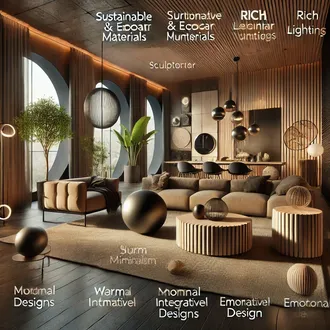Transcription Residential lighting
In addition to the aesthetic effects when placing the luminaires, the decorator must provide the necessary quantity and quality of light in each of the spaces, so that the client perceives the safety and lighting comfort of the home during the performance of their daily activities.
Although in residential lighting will always play a predominant role the client's taste, there are certain requirements that must be considered to ensure the welfare and performance of people in their daily chores; in this presentation we will refer to them taking into account the functions that are generally performed in each of the rooms of the house.
Living room lighting
Generally the living room and the living room should have a clear and luminous aspect, with an average general lighting level of about 200 lux, for which it is advisable to use luminaries of different characteristics, for example: luminaries embedded in the ceiling -downlights-, hanging luminaries and sconces or decorative lamps.
It is advisable to distribute the lighting of different groups of luminaires so that it is not necessary to turn on the room completely when it is not needed. For example, a specific circuit can be designed with an intensity between 60 and 70 lux for watching TV.
To generate dynamism, different patterns of diffusion and luminous intensity can be combined, making the pendant lights and sconces have various forms of indirect, semi-direct, diffuse, etc. distribution.
Luminaires and spotlights can be used to illuminate some areas of the walls and ceiling with warmer white lights of approximately 3000 k; small LED spotlights can also be used to concentrate the light on some objects, pictures, details, etcetera.
Dining room lighting
The dining room in many homes is integrated into the living room, making it necessary to emphasize the more intimate character of this space, so in addition to the general lighting provided by recessed or semi-recessed lamps in the ceiling, you should use another lamp that provides a spot light on the table.
A very usual solution is to place one or more luminaires hanging over the table that provide a level of illumination that can be regulated according to the moment, for example: during the meal, the light can be slightly warm and intense white and when the table is not used the area pelmaceria illuminated with a light perhaps warmer and less intense.
Kitchen lighting
The kitchen is the space that requires the most attention when planning the lighting of a home because of the variety of tasks that are performed there daily, both during the day and at night.
In the kitchen, although at least two different types of lighting should be used, both should be as bright as possible to easily identify any change in the color of the food. Here it is also advisable to spread the lighting of different groups of luminaires so that it is not necessary to switch on the kitchen completely when it is not needed.
Lighting systems used in the kitchen
General lighting system: It should provide about 300 lux uniformly throughout the space so that things can be found easily, even inside the cupboards. Whenever the position of the ceiling is horizontal and the furniture allows it, recessed or semi-recessed luminaires are used in the ceiling.
Spot lighting system: It should provide between 500 and 600 lux around the surfaces where food is prepared. They should be located in such a way as to avoid the projection of shadows on the work surface; as well as the dazzling of the people who are in the area. To take advantage of the space these lamps are usually placed recessed in the bottom of high cabinets or other structures such as counters or shelves. When they are more isolated, reflector lamps can be placed.
Ambient or zonal lighting system: When the kitchen has a dining area or simply a table for breakfast, it can be set in the same way as we recommend when the dining area is located in the living room area; however, here the light source must be very bright, since a warm light could interfere in the appreciation of the color of the food being prepared.
Bathroom lighting
The first thing to consider when planning bathroom lighting is safety, which is why we recommend LED luminaires powered by electrical circuits whose voltage does not exceed 12 volts and use IP68 connectors, specially designed for wet environments.
In bathrooms, in addition to the general lighting, it is necessary to differentiate the following two lighting zones:
- The vanity area, the mirror and the sink: it should be illuminated from different points with a very clear and intense light, so that when standing in front of the mirror on the face, the light rays fall on the face without shadows or dark areas. This effect can be achieved by placing sconces on both sides of the mirror.
- In this area, other secondary luminaires should also be used to create a warmer atmosphere. One of the variants could be to use colored LED strips, hidden behind the moldings of the mirror that illuminate all its contour.
- The shower or bathtub area: Generally in this area the lighting is done using recessed lights in the ceiling and walls. The light sources should be warmer to transmit a more comfortable atmosphere, you can also create different color effects, using LED strips or LED spots located at different points in the space.
Bedroom lighting
Many bedrooms in addition to general lighting and spot lighting at the head of the bed, require other types of lighting for other areas of the room depending on the furniture, for example: for watching television and for the dressing table.
Control of all lighting sources should always be located at the head of the bed, including general room lighting, although this source should also be controlled from a location near the front door of the room.
The lighting at the head of the bed should have two forms of lighting, one direct for reading and one diffused to set the mood for other activities.
Children's bedrooms, especially baby bedrooms, should have good general lighting (about 300 lux). Page break.
Lighting common areas
Common areas include hallways, corridors, stairways and other transit areas. The general luminosity in these spaces should be approximately 150 lux, so that people perceive adequate comfort and safety when passing through them; poorly illuminated common areas can be sources of accidents and depressing sensations.
When designing the lighting of these areas we must consider the levels of luminosity of the adjoining rooms, so that there are no significant contrasts that impair vision.
In these spaces the monotony of the general lighting should be broken by placing decorative sconces or other luminaires that help to highlight pictures, sculptures or plants conveniently distributed.
light residential




